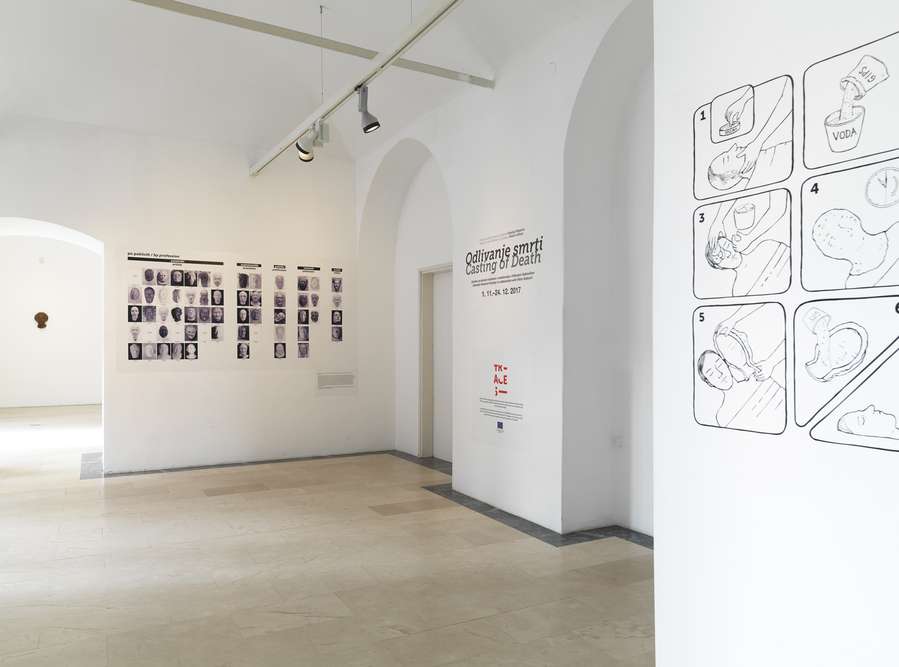Casting of Death
What is a death mask? What is its purpose? Is it a thing of the past or part of a living, yet overlooked practice in sculpture? How many death masks are kept in public collections across Slovenia? And who are the people whose faces were cast?
The casting of death masks is one of the oldest portrait sculpture techniques. Its popularity grew particularly in the 19th century with the growing assertion of the bourgeois social class, while museums also played a key part in the process. Death masks of personalities who were of major importance to the community functioned as a medium that was integrated into carefully structured political and social projects. The Domestic Research Society together with some external collaborators has been exploring this phenomenon and practice.
The exhibition focuses on the very practice of casting, keeping and storing death masks, as well as their multiple purposes. The contemporary practice of casting death masks was introduced to us by Viktor Gojkovič, academy-trained sculptor who has received the Stele lifetime achievement award for his work as a conservator. Having cast his first death mask in 1963, he has continued to do so to the present day. Some of his masks have found their way into the online database of death masks kept in Slovenian libraries, museums and archives, which the Domestic Research Society has been running in cooperation with the Institute of Contemporary History. Death masks can also serve as a source of inspiration. The Unknown Woman of the Seine (L'Inconnue de la Seine) has been attracting artists for more than a century (a replica of her death mask also appeared in Plečnik's legacy), and has, for more than a half of a century, been lending her face to the CPR training manikin (known as Resusci Anne). Several generations of such manikins are also kept at the Slovenian Red Cross.
The Casting of Death exhibition is part of the TRACES research project (Transmitting Contentious Cultural Heritages with the Arts: From Intervention to Co-Production), which has received funding from the European Union (Horizon 2020). Working groups named "Creative Co-productions" have been formed in Mediaș, Krakow, Ljubljana, Vienna, Berlin, Edinburgh and Belfast, combining artists, scientists and cultural heritage operators as equal partners. Paying special attention to the development of methodologies for artists to take part in interpreting potentially contentious cultural heritage, the TRACES project seeks to overcome the established practice of art interventions.
Colophon
Authors: Domestic Research Society in collaboration with Viktor Gojkovič
Creative Co-production (TRACES): Damijan Kracina, Alenka Pirman, Jani Pirnat (Domestic Research Society); Marko Jenko (Museum of Modern Art); Janez Polajnar (City Museum of Ljubljana); Marijan Rupert (National and University Library); Blaž Bajič (University of Oslo); Maruša Kocjančič (documentalist)
Produced by: Domestic Research Society, Museum and Galleries of Ljubljana
The exhibition was made possible by: City of Ljubljana
Acknowledgments: Mitja Doma, Maša Ekar, Janja and Viktor Gojkovič, Jurij Hadalin, Gisela Hagmair, Erica Lehrer, Andrej Pančur, Mojca Šorli, Katarina Toman Kracina, Institute of Contemporary History, Museum of Modern Art, National and University Library, Slovenian Red Cross, Ljubljana local branch
TRACES partners: Universität Klagenfurt (Austria), Politecnico di Milano (Italy), Zürcher Hochschule der Künste (Switzerland), Hosman Durabil (Romania), Naturhistorisches Museum Wien (Austria), University of Edinburgh (Great Britain), Uniwersytet Jagiellonski (Poland), University of Ulster (Great Britain), Humboldt-Universität zu Berlin (Germany), Universitet i Oslo (Norway) and Domestic Research Society (Slovenia)
The exhibition is part of the TRACES project, which has received funding from the European Union’s Horizon 2020 research and innovation programme under grant agreement No. 693857. The views expressed here are the sole responsibility of the authors and do not necessarily reflect the views of the European Commission.
Location
Trg francoske revolucije 7
1000 Ljubljana
T +386 1 24 12 590
T +386 1 24 12 500
E galerija.vzigalica@mgml.si
Opening hours
Tuesday–Sunday: 10 a.m.–6 p.m.
Monday: Closed
1 January, 1 November, 25 December: Closed
24 and 31 December: 10 a.m.–2 p.m.
Tickets
Free entry.
News
Casting death masks is one of the oldest sculptural portrait techniques. Immediately after the passing of an important individual, a professional sculptor created a mould of his face and cast a limited number of masks in wax or plaster.

